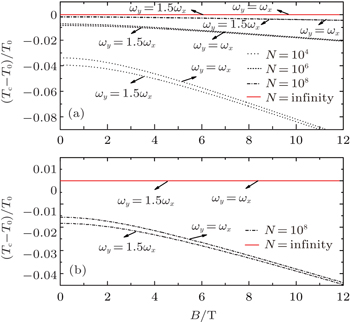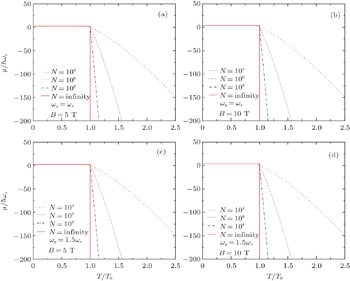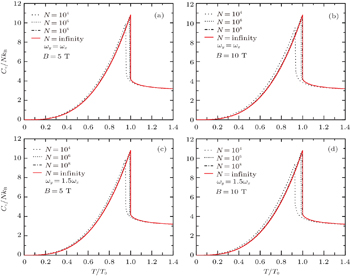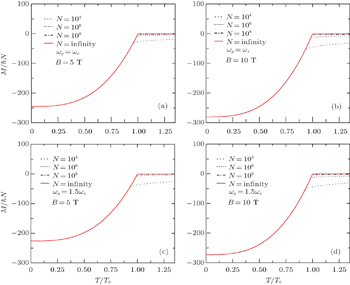† Corresponding author. E-mail:
Project supported by the National Natural Science Foundation of China (Grant No. 11375090), and the K. C. Wong Magna Foundation of Ningbo University, China.
We investigate the thermodynamic properties of an ideal charged Bose gas confined in an anisotropic harmonic potential and a constant magnetic field. Using an accurate density of states, we calculate analytically the thermodynamic potential and consequently various intriguing thermodynamic properties, including the Bose–Einstein transition temperature, the specific heat, magnetization, and the corrections to these quantities due to the finite number of particles are also given explicitly. In contrast to the infinite number of particles scenarios, we show that those thermodynamic properties, particularly the Bose–Einstein transition temperature depends upon the strength of the magnetic field due to the finiteness of the particle numbers, and the collective effects of a finite number of particles become larger when the particle number decreases. Moreover, the magnetization varies with the temperature due to the finiteness of the particle number while it keeps invariant in the thermodynamic limit N → ∞.
The ideal charged Bose gas (CBG) consists of a gas of spin-less, charged bosons coupled to an external homogeneous magnetic field has played a significant role in understanding lots of exotic quantum phenomena including superfluidity and superconductivity. The study of the CBG has a long history and it is impossible to give a complete list here. Perhaps, the first investigation in three dimensions was performed more than half a century ago by Osboren, [ 1 ] and then by Schafroth [ 2 ] who showed that Bose–Einstein condensation (BEC) [ 3 – 7 ] cannot exist at any finite temperature in the presence of a homogeneous magnetic field. However, the system does exhibit the essential equilibrium features of a superconductor such as the Meissner–Ochsenfeld (MO) effect at lower temperatures in a magnetic field. May [ 8 , 9 ] extended this idea to a D -dimensional CBG and pointed out the BEC in CBG can take place only if D ≥ 5. Toms [ 10 , 11 ] subsequently argued that BEC cannot occur in the CGB in any spatial dimension D , while Rojas [ 12 ] has pointed out that BEC can take place with a diffuse transition. May’s work was confirmed and extended by Daicic and Frankel. [ 13 ] A semiclassical approach was used by Bayindir and Tanatar [ 14 ] to conclude that BEC can occur in the CBG in a magnetic field and in the presence of a crossed electric field. The thermodynamic properties of the 2D CBG in a magnetic field has also been investigated by van Zyl and Hutchinson. [ 15 ]
In recent years, with rapid progress in ultracold atoms, there has been a renewed interest in charged bosons. In a properly designed laser field, the center-of-mass (CM) motion of neutral atoms may mimic the dynamics of a charged particle in a magnetic field. [ 16 ] Alternatively, one can spin up the neutral atoms by confining them in a rotating frame. [ 17 ] Since the atomic gases of the experiments for BEC are dilute, as a first approximation the ideal Bose gas is a good starting model to explore theoretically in terms of basic interatomic interactions. Although not the focus of rotating Bose gases research, the thermodynamic properties of the rotating ideal Bose gases have also been studied by various authors. [ 18 – 23 ] In particular, the ideal CGB in a magnetic field was taken as an example to investigate the thermodynamic properties of rotating ideal Bose gases by the authors of Ref. [ 24 ]. The system they considered is placed in a uniform magnetic field and a harmonic trap

However, it is well known that in real experiment conditions, the number of trapped atoms N is finite ranging from a few thousand [ 25 ] to a few million, [ 26 ] the thermodynamic limit approximation may not be available. Actually, there are quite a lot of works dealing with this issue for the Bose gases. [ 27 – 35 ] Hence, in this paper we investigate the effects of a finite number of particles on the thermodynamic properties of an ideal charged Bose gas confined in an anisotropic harmonic potential and a constant magnetic field. Using an accurate density of states, we first calculate analytically the thermodynamic potential, then various thermodynamic properties including the Bose–Einstein transition temperature, the specific heat, and magnetization are analyzed. The corrections to these quantities due to the effects of a finite number of particles are also given explicitly. In particular, we show that the BEC condensation temperature is relevant to the magnetic field and the magnetization varies with the temperature when the particle number is finite. These behaviors are quite different from the infinite particle number case.
The rest of the paper is organized as follows. In Section 2, we introduce the Hamiltonian of the system and give the energy spectrum. The thermodynamic potential and various thermodynamic potentials are obtained and analyzed in Section 3, concluding remarks are made in the last section.
The ideal charged Bose gas we consider consists of N bosons with mass m and charge e > 0, is trapped in a harmonic confining potential which is anisotropic in all three dimensions [ 26 , 36 ] described by








The corresponding eigenfunctions for the Hamiltonian of Eq. ( 
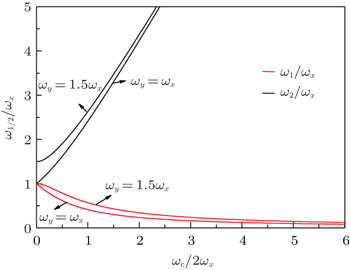 | Fig. 1. The ω 1,2 / ω x as functions of the cyclotron frequency ω c = eB /( mc ) (in units of 2 ω x ), which is proportional to the strength of the magnetic field B . |
Hence, the energy levels of the total model Hamiltonian are

In this section, we first calculate the thermodynamic potential, then the transition temperature and condensate fraction are obtained by taking into account the fact that the particle number N is finite. Finally, we calculate the specific heat and magnetization.
The thermodynamic potential of the system is [ 38 ]








When the temperature is above the BEC temperature T c , the chemical potential μ is less than the ground state energy, μ < E 0 . Thus, E n ‒ μ ≠ 0 and C n = 0 for all levels. As the temperature decreases, the chemical potential μ increases and reaches E 0 at or below T c . Then C 0 ≠ 0 becomes the only nonzero solution of all C n , which means the corresponding condensate wave function is Ψ (






The second part of the thermodynamic potential is









Having obtained the analytical expression for the thermodynamic potential in the above subsection, we next proceed to calculate the expression for the particle number N which can be derived via the equation N = − ∂Ω / ∂μ . The transition temperature and condensate fraction then can be obtained from the equation for the particle number.
Employing Eqs. (



When T = T c , the number of particles condensed on the ground state is pretty large N 0 ≫ 1 but still N 0 ≪ N . Hence we can ignore N 0 in Eq. (


Note here, in the thermodynamic limit, the second term in the bracket of Eq. (

Combining Eqs. (

We plot the ratio ( T c − T 0 )/ T 0 as a function of the strength of the magnetic field B in Fig.
Next, let us examine the condensate fraction, i.e., the ratio of the number of condensate particles to the total particle number for T < T c . Since N 0 ≫ 1 in this case, we may substitute z ≈ 1 in Eq. (



In this subsection, we investigate the chemical potential μ , or equivalently z = e β ( μ − E 0 ) . Since it is clear when T ≤ T c , μ = E 0 , we only need to find out μ when T > T c . As discussed earlier, N 0 = 0 when T > T c , hence, equation (

In the thermodynamic limit N ≫ 1, we can ignore the last term of Eq. (



In this subsection we calculate the specific heat. The specific heat can be calculated by differentiating the internal energy U with respect to the temperature C v ( T ) = ∂U / ∂T . The internal energy is given by




Similarly, the magnetization can be obtained from the thermodynamic potential







The magnetization M as functions of T / T 0 for different values of B and N is plotted in Fig.
From the expressions above, we can see that the magnetization M does depend on B , since ∂γ / ∂B ≠ 0. This point is clearly reflected in Fig.
First, M/N as a function of T/T 0 (Eqs. (
In summary, by employing an accurate density of states, we calculate analytically the thermodynamic potential of an ideal charged Bose gas confined in an anisotropic harmonic potential and a constant magnetic field. Then we obtained the expressions for the Bose–Einstein transition temperature, condensate fraction, the specific heat and magnetization taking into account the fact that the particle number N is finite. These thermodynamic properties are then investigated for different values of particle number N , strength of the magnetic field B , and different degrees of anisotropy for the confining harmonic potential. In contrast to the infinite number of particles case which has been investigated in Ref. [ 24 ], we show that those thermodynamic properties, in particular Bose–Einstein transition temperature, depends upon the strength of the magnetic field due to the finiteness of the particle numbers, and the collective effects of a finite number of particles become larger when the particle number decreases. Furthermore, the magnetization varies with the temperature due to the finiteness of the particle number while it stays invariant in the thermodynamic limit N → ∞.
| 1 | |
| 2 | |
| 3 | |
| 4 | |
| 5 | |
| 6 | |
| 7 | |
| 8 | |
| 9 | |
| 10 | |
| 11 | |
| 12 | |
| 13 | |
| 14 | |
| 15 | |
| 16 | |
| 17 | |
| 18 | |
| 19 | |
| 20 | |
| 21 | |
| 22 | |
| 23 | |
| 24 | |
| 25 | |
| 26 | |
| 27 | |
| 28 | |
| 29 | |
| 30 | |
| 31 | |
| 32 | |
| 33 | |
| 34 | |
| 35 | |
| 36 | |
| 37 | |
| 38 | |
| 39 | |
| 40 |




